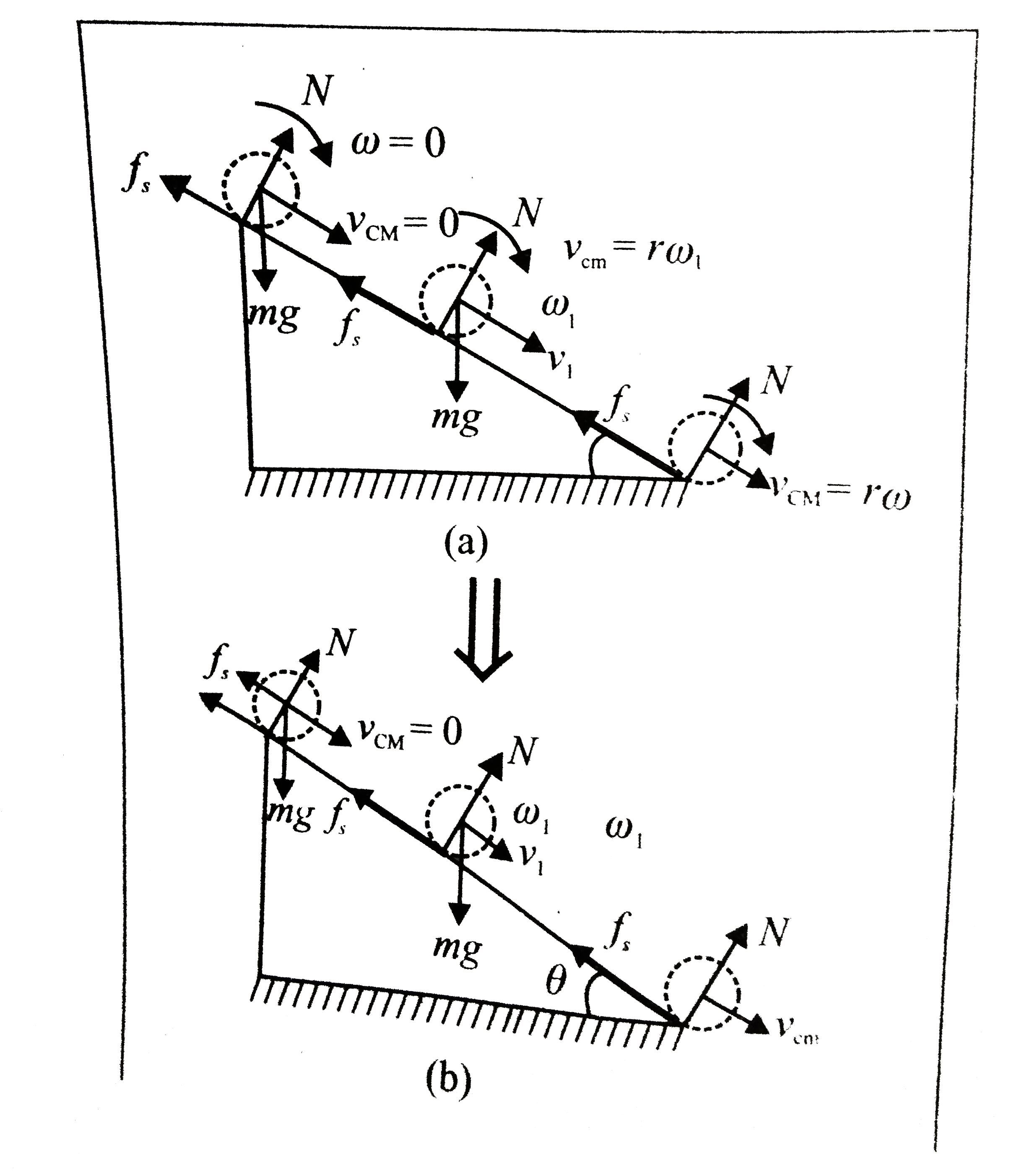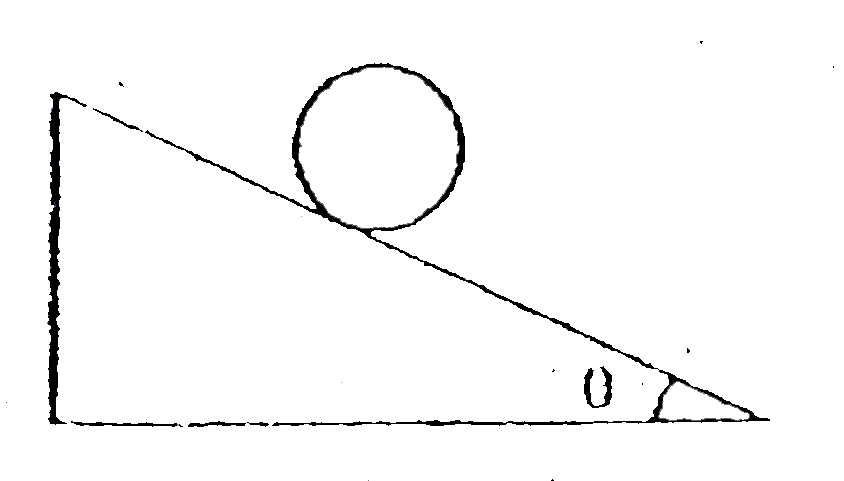A solid cylinder of mass M and radius R rolls down an inclined plane without slipping. THE speed of its centre of mass when it reaches the bottom is
First method: "Force/Torque" Method
We can use the formula which we derived
a=gsinθ1+k2R2……..i
For cylinder I=mR22⇒k2=R22
Hence, acceleration of the cylinder a=23gsinθ
Let vCM be the velocity of the centre of mas at the bottom. From equation v2=u2+2as,
v2CM=02+2(23gsinθ)(hsinθ)=43gh
⇒vCM=√43gh
Second method: By Mechanical Energy Conservation
When the non conservative forces do not perform ay work on a system (Wnef=0), the mechanical energy(K+U) of the system remains constant.
Here Wf=0(because the velocity of the instantaneous point of contact is always zero)
WN=0(because the velocity of the instantaneous point of contact is always zero)
Thus, Wnef=0
The mechanical energy of the cylinder will remain constant.
(K+U)top=(K+U)bottom
⇒0+mgh=12mv2CM+12ICMω2+0
=12mv2CM+12(12mr2)(vCMr)2
(vCM=rω, for rolling)
=12mv2CM+14mv2CM⇒mgh=34mv2CM
⇒vCM=√43gh
Third Method: Using work energy Theorem (ΣW=△K)
Wf+WN+Wmg=K2−K1
⇒0+0+(mg)h=(12mv2CM+12ICMω2)
⇒mgh=12mv2CM⇒mgh=34mv2CM
⇒vCM=√43gh
Fourth Method: Using work Ennergy Theorem Separately in Translational Motion and Rotational Motion
The rolling motioin of the cylinder is obtained by superimposing the translation and rotational motions, translational motion of the centre of mass and rotational motion about an axis passing through the centre of mass, cylinder's own axis.
you can apply the work energy theorem for the translational and rotatioinal components of the motion separately as under:
ΣWforce=△Ktranslation
and. ΣWtorque=(△Krotational)
The two forces acting at the point of contact, fs and N can be translated to the centre of mass after applying an equivalent torque as shown in figure.
For the translational part of the motion.
Wf+WN+W(mg)=K2−K1

⇒−fs(hsinθ)+0+h=12mv+(CM)1−0
For the rotational part,
Torque × Angular displacement =12ICMω2−0
⇒(fs.r)⎛⎝hsinθr⎞⎠=12ICMω2−0
(Wτ=τθ) is τ is contant and θ1 and τ are in the same sense of rotation where θ1 is the angle through which the cyinder rotates about the centre of mass axis. Here, for rolling, vCM=rωs,aCM=rα and s=rθ1)
Thus fs(hsinθ)=12ICMω2
From the above equations, we get
mgh=12mv2CM+12ICM+ω2CM
=34mv2CM+,ICM=12mr2
⇒vCM=√43gh
Fifth method:

About the instantaneous point of contact, the torque acting on the cylinder is
(→τ=fs×0+N)+(mg)(rsinθ)
=mgrsinθ(−ˆk)(clockwise)
Angular momentum of the cylinder about the instantaneous point of contact in the clockwise sense,
→L=[ICMω+mvCMr](−ˆk)
[(12mr2)(vCMr)+mvCMr](−ˆk)=32mrvCM(−ˆk)
now, from the equation →τ=−→dLdt,
mgrsinθs=ddt(32mrvCM)
Here →rτ=−→dLdt has been applied about the instantaneous point of contact).
⇒mgrsinθ32mrdvCMdt=32mraCM
⇒aCM=32gsinθ
Now from the equation v2=u2+2as, we get
v2CM=02+2(23gsinθ)(hsinθ)
⇒vCM=√43gh
Alternative Method: You can also manipulate Eqn i as follows
mgrsiθ=ddt(32mrvCM)
gsinθ=32dvCMdt=32dvCMdxdxdt=32vCMdvCMdx)
⇒gsinθdx=32vCMdvCM
∫h/sinθ0gsinθdx=∫vCM032vCMdvCM
⇒gh=34v2CM⇒vCM=√43gh
Topper's Solved these Questions
- BOOK - CENGAGE PHYSICS ENGLISHCHAPTER - RIGID BODY DYNAMICS 2EXERCISE - Solved Examples12videos
RIGID BODY DYNAMICS 2
- BOOK - CENGAGE PHYSICS ENGLISHCHAPTER - RIGID BODY DYNAMICS 2EXERCISE - Exercise 3.111videos
RIGID BODY DYNAMICS 2
- BOOK - CENGAGE PHYSICS ENGLISHCHAPTER - RIGID BODY DYNAMICS 1EXERCISE - Integer11videos
RIGID BODY DYNAMICS 1
- BOOK - CENGAGE PHYSICS ENGLISHCHAPTER - SOUND WAVES AND DOPPLER EFFECTEXERCISE - Integer16videos
SOUND WAVES AND DOPPLER EFFECT
Similar Questions
A solid cylinder of mass M and radius R rolls down an inclined plane of height h without slipping. The speed of its centre when it reaches the bottom is.
View SolutionA solid cylinder of mass M and radius R rolls down an inclined plane of height h. The angular velocity of the cylinder when it reaches the bottom of the plane will be :
View Solution
Knowledge Check
- Question 1 - Select One
A solid cylinder of mass M and radius R rolls without slipping down an inclined plane making an angle 6 with the horizontal. Then its acceleration is.
A1/3 g sinθB2/3 g sinθC2/5 g sinθD2/7 g sinθ
A cylinder of mass M and radius R rolls on an inclined plane. The gain in kinetic energy is
View SolutionA solid cylinder is rolling down the inclined plane without slipping. Which of the following is correct?
 View Solution
View SolutionIf a solid cylinder rolls down an inclined plane, then its:
View SolutionA ring starts to roll down the inclined plane of height h without slipping . The velocity when it reaches the ground is
View SolutionA solid cylinder of mass M and radius R rolls without slipping down an inclined plane of length L and height h. What is the speed of its center of mass when the cylinder reaches its bottom
View SolutionA solid cylinder of mass M and radius R rolls from rest down a plane inclined at an angle θ to the horizontal. The velocity of the centre of mass of the cylinder after it has rolled down a distance d is :
View SolutionThe M.I. of a solid cylinder about its axis is I. It is allowed to rool down an incline plane without slipping. If its angular velocity at the bottom be ω, then kinetic energy of rolling cylinder will be
View Solution
